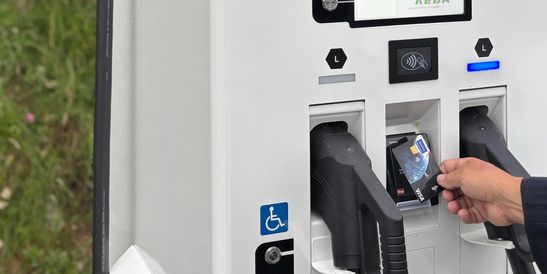More than green: Sustainable charging solutions made in Austria
- Knowledge
- Sustainability
- 11.8.2025
- Reading Time: {{readingTime}} min

Contents
Quality & Innovation Made in Austria
Regional value creation, short supply chains, fair conditions
Our products are created where expertise, responsibility, and progress come together: in Austria. Our AC wallboxes, such as the KeContact P40, are developed and manufactured in Linz. Our DC charging systems are produced at our specialized competence centers in Oberlienz and Kötschach-Mauthen. The entire manufacturing process is powered by 100% green electricity, and many components are sourced from within a 500 km radius.
We take a long-term view of charging infrastructure: Products like the KeContact P40 are modular in design and receive regular software updates. This ensures they remain technologically up to date, even many years after installation. We also operate our own refurbishment line, where used devices are inspected, upgraded, and reintroduced into the market — an active contribution to the circular economy.

KeContact P40: Sustainability taken one step further
Optimized from design to the final layer of packaging
With the introduction of the KeContact P40, we have deliberately implemented measures to further reduce the ecological footprint across the entire product lifecycle.
A key element: the intelligent packaging design. By reducing the volume by 40%, we not only save material but also cut CO₂ emissions during transport. The packaging is over 87% recyclable and nearly plastic-free.
Thanks to optimized pallet utilization, 36 boxes now fit on a pallet instead of 24, significantly lowering transport emissions.
In operation, the KeContact P40 impresses with energy-efficient features such as PV-optimized charging, as well as standby and sleep modes. The modular device design allows for simple on-site repairs, such as replacing the charging cable directly in the field. This extends the product’s lifespan and avoids electronic waste.


87
Percentage of recyclable packaging

40
Percentage reduction in packaging volume

25
Percentage of CO₂ savings with the KeContact P40
20000
Refurbished devices in the refurbishment process
Sustainability in the high-power segment
Durable, low-maintenance, and built for long life cycles
Sustainability for us doesn’t stop at AC wallboxes — it also applies to our DC product portfolio. Especially in the case of high-power fast charging infrastructure, a sustainable use of resources is crucial: through durability, reparability, and reliable performance in continuous operation.
Our DC charging stations are certified according to all relevant standards and have been developed with high-quality components, modular architecture, and protection against extreme temperatures — specifically designed for tough operating conditions. This resilience extends the product lifecycle and reduces maintenance to a minimum.
In terms of sustainability, each DC charging station is also:
- Remotely maintainable, to avoid unnecessary on-site visits
- Locally serviceable, thanks to partnerships with certified regional service providers
- Modular in design, allowing individual components to be replaced when needed
A real-world example: If a power module fails in a DC charging system, the station remains operational at reduced power thanks to its redundant design. There’s no need to replace the entire unit. Remote maintenance allows the issue to be diagnosed in advance, enabling targeted service — conserving resources, saving time, and making economic sense.
These features make our DC systems the ideal solution for company fleets, CPOs, and operators with high demands — because truly sustainable e-mobility only works if the charging infrastructure is sustainable as well.

Conclusion: Sustainability that thinks ahead.
Whether AC wallbox or DC fast charging station, whether a stand-alone solution or a complex charging network — for us, sustainability is not an add-on, but a fundamental part of the design. Through long-lasting construction, energy-efficient features, regional production, and intelligent services, we create charging infrastructure that combines technological excellence with ecological responsibility.
Made in Austria means for us: short supply chains, fair conditions, and the highest quality — but also the commitment to align our actions sustainably. For our customers. For our environment. For the future of mobility.








